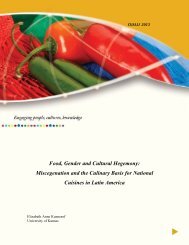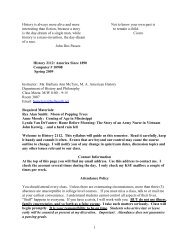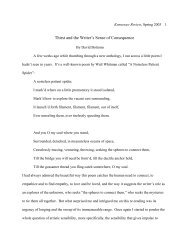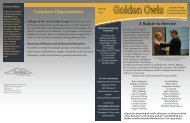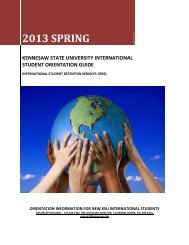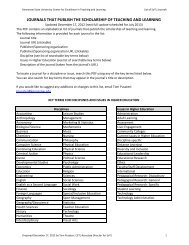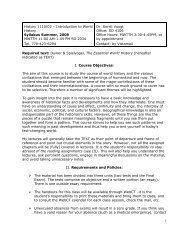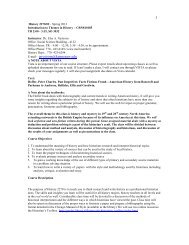KSU Wind Ensemble - Kennesaw State University
KSU Wind Ensemble - Kennesaw State University
KSU Wind Ensemble - Kennesaw State University
Create successful ePaper yourself
Turn your PDF publications into a flip-book with our unique Google optimized e-Paper software.
Upcoming Music Events<br />
Thursday, March 29, 2012<br />
<strong>KSU</strong> Faculty Jazz Recital<br />
8:00 pm • Bailey Performance Center Performance Hall<br />
Tuesday, April 3, 2012<br />
<strong>KSU</strong> Mixed Chamber <strong>Ensemble</strong>s<br />
8:00 pm • Bailey Performance Center Performance Hall<br />
Wednesday, April 4, 2012<br />
<strong>KSU</strong> Classical Guitar <strong>Ensemble</strong><br />
8:00 pm • Bailey Performance Center Performance Hall<br />
Thursday, April 5, 2012<br />
<strong>KSU</strong> Mixed Chamber <strong>Ensemble</strong>s<br />
8:00 pm • Bailey Performance Center Performance Hall<br />
Tuesday, April 10, 2012<br />
<strong>KSU</strong> Trombone Choir<br />
8:00 pm • Bailey Performance Center Performance Hall<br />
Wednesday, April 11, 2012<br />
<strong>KSU</strong> Jazz Combos<br />
8:00 pm • Bailey Performance Center Performance Hall<br />
Thursday, April 12, 2012<br />
<strong>KSU</strong> Student Composers<br />
8:00 pm • Bailey Performance Center Performance Hall<br />
Saturday, April 14, 2012<br />
<strong>KSU</strong> Community & Alumni Choir<br />
8:00 pm • Bailey Performance Center Performance Hall<br />
For the most current information, please visit<br />
http://www.kennesaw.edu/arts/events/<br />
Ladies and Gentlemen, welcome to the Bailey Performance Center. As a<br />
reminder, please silence or power off all mobile phones, audio/video recording<br />
devices, and other similar electronic devices. The performers, and your fellow<br />
audience members, will greatly appreciate it. Thank you, and enjoy the<br />
performance!<br />
We welcome all guests with special needs and offer the following services: easy<br />
access, companion seating locations, accessible restrooms, and assisted listening<br />
devices. Please contact an audience services representative to request services.<br />
presents<br />
A Concerto... A Symphony... and Sousa!<br />
featuring<br />
<strong>KSU</strong> <strong>Wind</strong> <strong>Ensemble</strong><br />
David Thomas Kehler, conductor<br />
with special guest<br />
Bernard Flythe, tuba<br />
Wednesday, March 28, 2012<br />
8:00 pm<br />
Dr. Bobbie Bailey & Family Performance Center<br />
Eightieth Concert of the 2011-2012 Season
<strong>Kennesaw</strong> <strong>State</strong> <strong>University</strong><br />
School of Music<br />
A Concerto... A Symphony... and Sousa!<br />
featuring Bernard Flythe, tuba<br />
Lauds, Praise High Day! (1992)<br />
Program<br />
Ron Nelson<br />
(b. 1929)<br />
Music at <strong>Kennesaw</strong> <strong>State</strong> <strong>University</strong><br />
Whether you are looking to become a dedicated and effective educator, seek<br />
focused training in performance, or have a strong interest in music but want to<br />
balance that with other academic interests, the School of Music at <strong>Kennesaw</strong><br />
<strong>State</strong> <strong>University</strong> offers an excellent place to challenge yourself in a nurturing and<br />
supportive environment.<br />
Accredited by the National Association of Schools of Music and recently<br />
designated an All Steinway School, the School of Music offers Bachelor of<br />
Music degrees in Music Education and Performance, as well as a Bachelor of<br />
Arts degree in Music. The <strong>KSU</strong> music curriculum provides rigorous training in<br />
music theory and aural skills, applied lessons, ensemble experience, and an<br />
exposure to the history of Western music as well as world music.<br />
Hymn to a Blue Hour (2010)<br />
John Mackey<br />
(b. 1973)<br />
Concerto for Tuba (1987)<br />
Bruce Broughton<br />
I. Allegro moderato (b. 1945)<br />
II. Aria<br />
III. Allegro leggero<br />
Bernard Flythe, tuba<br />
Intermission<br />
Symphony No. 4, Op. 165 (1958)<br />
Alan Hovhaness<br />
I. Andante Allegro (1911-2000)<br />
II. Allegro<br />
III. Andante, Allegro<br />
The faculty of the School of Music consists of committed artist-teachers: a<br />
strong core of resident faculty, complemented by distinguished members of the<br />
Atlanta Symphony Orchestra, Atlanta Opera Orchestra and Cobb Symphony<br />
Orchestra. Music students at <strong>KSU</strong> benefit from world-class instruction, vibrant<br />
and challenging performance opportunities, and the chance to immerse<br />
themselves in metropolitan Atlanta’s rich musical culture.<br />
The School of Music presents more than 150 performances each year, from<br />
chamber music to full orchestra, choral and wind ensemble concerts, and<br />
musical theatre and opera productions, with repertoire from traditional classical<br />
to modern jazz. Our state-of-the art facilities, our team of committed faculty and<br />
staff, and the breadth of musical opportunity make <strong>KSU</strong> an exciting choice for<br />
dedicated musicians. All this is done in a very personalized setting. For more<br />
information about our programs, please visit us on the web at<br />
www.kennesaw.edu/music.<br />
The Black Horse Troop (1924)<br />
John Philip Sousa<br />
(1854-1932)
<strong>Kennesaw</strong> <strong>State</strong> <strong>University</strong><br />
School of Music Faculty<br />
<strong>KSU</strong> <strong>Wind</strong> <strong>Ensemble</strong> personnel<br />
Woodwinds<br />
Robert Cronin, flute<br />
Cecilia Price, flute<br />
Christina Smith, flute<br />
Elizabeth Koch, oboe<br />
Dane Philipsen, oboe<br />
John Warren, clarinet<br />
Laura Najarian, bassoon<br />
Sam Skelton, saxophone<br />
Brass & Percussion<br />
Thomas Hooten, trumpet<br />
Jennifer Marotta, trumpet<br />
Thomas Witte, horn<br />
George Curran, trombone<br />
Tom Gibson, trombone<br />
Michael Moore, tuba/euphonium<br />
Bernard Flythe, tuba/euphonium<br />
John Lawless, percussion<br />
Strings<br />
Helen Kim, violin<br />
Allyson Fleck, viola<br />
Catherine Lynn, viola<br />
Charae Krueger, cello<br />
Douglas Sommer, double bass<br />
Elisabeth Remy Johnson, harp<br />
Mary Akerman, classical guitar<br />
Trey Wright, jazz guitar<br />
Marc Miller, jazz bass<br />
<strong>Ensemble</strong>s & Conductors<br />
Leslie J. Blackwell, choral activities<br />
Alison Mann, choral activities<br />
Russell Young, opera & musical theatre<br />
Eileen Moremen, opera<br />
Michael Alexander, orchestras<br />
John Culvahouse, wind ensembles<br />
David Kehler, wind ensembles<br />
Oral Moses, gospel choir<br />
Wes Funderburk, jazz ensembles<br />
Sam Skelton, jazz ensembles<br />
Trey Wright, jazz<br />
Voice<br />
Adam Kirkpatrick<br />
Eileen Moremen<br />
Oral Moses<br />
Valerie Walters<br />
Jana Young<br />
Russell Young, vocal coach<br />
Piano<br />
Robert Henry<br />
Tyrone Jackson, jazz piano<br />
John Marsh<br />
David Watkins<br />
Susan White<br />
Soohyun Yun<br />
Music History & Appreciation<br />
Judith Cole<br />
Drew Dolan<br />
Edward Eanes<br />
David Kehler<br />
Alison Mann<br />
Oral Moses<br />
Katherine Morehouse<br />
Music Education<br />
Janet Boner<br />
Kathleen Creasy<br />
John Culvahouse<br />
Margaret Grayburn<br />
Barbara Hammond<br />
Hollie Lawing<br />
Alison Mann<br />
Angela McKee<br />
Richard McKee<br />
Terri Talley<br />
Amber Weldon-Stephens<br />
Music Theory, Composition,<br />
& Technology<br />
Judith Cole<br />
Drew Dolan<br />
Allyson Fleck<br />
Tom Gibson<br />
Jennifer Mitchell<br />
Laurence Sherr<br />
Benjamin Wadsworth<br />
Chamber Music<br />
Allyson Fleck<br />
Helen Kim<br />
Charae Krueger<br />
Alison Mann<br />
Jennifer Marotta<br />
Soohyun Yun<br />
<strong>Ensemble</strong>s in Residence<br />
<strong>KSU</strong> Faculty String Trio<br />
<strong>KSU</strong> Faculty Chamber Players<br />
Atlanta Symphony Brass Quintet<br />
Atlanta Percussion Trio<br />
Georgia Youth Symphony Orchestra<br />
and Chorus<br />
Flute/Piccolo<br />
Mia Athanas, Marietta<br />
Holly Botella, Peachtree City<br />
Catherine Flinchum, Woodstock<br />
Stephanie Fudge, Acworth<br />
Darcy Parker, Woodstock<br />
Dirk Stanfield, Amarillo, TX<br />
Oboe/English Horn<br />
Harrison Bennett, Suwanee<br />
Lisa Mason, Clyo<br />
Alejandro Sifuentes, Lawrenceville<br />
Clarinet<br />
Katherine Cook, Loganville<br />
Krista Coutts, Woodstock<br />
Rachael Eister, <strong>Kennesaw</strong><br />
Ben Hoffman, Atlanta<br />
Kadie Johnston, Buford<br />
May Langhorne, Marietta<br />
Christopher Malloy, Jasper<br />
Bora Moon, Seoul, South Korea<br />
Bass Clarinet/Contra Alto Clarinet<br />
May Langhorne, Marietta<br />
Christopher Malloy, Jasper<br />
Bassoon/Contra Bassoon<br />
Jordan Alfredson, Conyers<br />
Jesse Carlson, Lilburn<br />
Sarah Fluker, Decatur<br />
Saxophone<br />
Jason Lee Kaplan, Alpharetta<br />
Michael LaRose, Nicholson<br />
Devin Okey, Elberton<br />
Christopher Otts, Augusta<br />
Drew Paller, Marietta<br />
Horn<br />
David Anders, <strong>Kennesaw</strong><br />
Alex Depew, Acworth<br />
Megan Gribble, Marietta<br />
Chloe Lincoln, <strong>Kennesaw</strong><br />
Connor Osburn, Marietta<br />
Trumpet<br />
Brandon Austin, Conyers<br />
John Thomas Burson, Acworth<br />
Sam Coleman, Marietta<br />
Michael Edalgo, Cordele<br />
Tyler Elvidge, <strong>Kennesaw</strong><br />
Pete Hall, Covington<br />
Jackson Harpe, Marietta<br />
Turner Millsaps, Peachtree City<br />
Justin Rowan, Woodstock<br />
Trombone<br />
George Blevins, Marietta<br />
Robert Dixon, Ball Ground<br />
David Lennertz, <strong>Kennesaw</strong><br />
Michael Lockwood, Augusta<br />
Jordan Sellers, Marietta<br />
Tim Settineri (Bass), Marietta<br />
Euphonium<br />
Kristopher Davis, <strong>Kennesaw</strong><br />
Greg Hicks, Lawrenceville<br />
Michael Terry, Woodstock<br />
Tuba<br />
Austin Baxley, Acworth<br />
Melinda Mason, Atlanta<br />
Double Bass<br />
Samantha Griffith, Marietta<br />
Britton Wright, Lawrenceville<br />
Percussion<br />
Robert Boone, Augusta<br />
Levi Cull, Richmond, VA<br />
Ian Kennel, Acworth<br />
Katelyn King, <strong>Kennesaw</strong><br />
Erik Kosman, Sturgis, MI<br />
Katie Lawrence, Marietta<br />
Levi Lyman, Americus<br />
Harrison Ude, Marietta<br />
Brandon Worley, Ball Ground<br />
Piano/Celeste/Electric Keyboard<br />
Joanne Allison, Gainesville<br />
Ariel Ginn, Marietta<br />
Harp<br />
Tyler Hartley, Marietta<br />
Assistant to the Director of Bands<br />
David Collins, Sumter, SC
David Thomas Kehler<br />
conductor<br />
Since 2009, David Kehler has served as Director of Bands at <strong>Kennesaw</strong> <strong>State</strong><br />
<strong>University</strong>. Here, he oversees all aspects of the <strong>University</strong>’s band program<br />
while serving as Music Director and Conductor of the <strong>KSU</strong> <strong>Wind</strong> <strong>Ensemble</strong>.<br />
During his short tenure, the <strong>KSU</strong> <strong>Wind</strong> <strong>Ensemble</strong> has been featured on 90.1<br />
FM (WABE- Atlanta public radio), and has garnered praise from composers<br />
including Steven Bryant, Karel Husa, David Maslanka, Michael Markowski,<br />
Scott McAllister, and Joel Puckett. In addition, the <strong>KSU</strong> <strong>Wind</strong> <strong>Ensemble</strong> was<br />
a featured ensemble at the 2012 Southern Division College Band Directors<br />
National Conference. Dr. Kehler also teaches courses in advanced<br />
instrumental conducting, wind literature, and chamber music. In addition to<br />
Professor Kehler’s <strong>KSU</strong> responsibilities, he currently serves as Interim<br />
Conductor of the Atlanta Youth <strong>Wind</strong> Symphony during its principal<br />
conductor’s sabbatical.<br />
Previously, David Kehler served The <strong>University</strong> of Texas at Austin as a<br />
Graduate Conducting Associate receiving a Doctor of Musical Arts degree.<br />
From 2001-2009, Dr. Kehler served as Associate Conductor of America’s<br />
Premier <strong>Wind</strong>band; The Dallas <strong>Wind</strong> Symphony where he was the director of<br />
the Dallas <strong>Wind</strong> Symphony International Fanfare Project. In addition, Dr.<br />
Kehler conducted the Dallas <strong>Wind</strong> Symphony throughout Texas, including<br />
the annual Labor Day Concert at the Dallas Arboretum, various Chautauqua<br />
festivals, holiday concerts, and a formal gala presented by the United <strong>State</strong>s<br />
Armed Forces with all of the Joint Chiefs of Staff in attendance.<br />
While in Texas, Dr. Kehler was also Founder and Conductor of the GDYO<br />
<strong>Wind</strong> Symphony, an ensemble affiliated with the Greater Dallas Youth<br />
Orchestras, Inc. During his ten years of service, the GDYO <strong>Wind</strong> Symphony<br />
established itself as one of the premier youth wind ensembles in the United<br />
<strong>State</strong>s. They were a featured ensemble at the Texas Bandmasters<br />
Association/National Band Association Convention in San Antonio, Texas,<br />
and were heard internationally on “From the Top”, a syndicated radio<br />
program featuring the finest young classical musicians in the country. In<br />
addition, the GDYO <strong>Wind</strong> Symphony participated in exchange concerts with<br />
the Atlanta Youth <strong>Wind</strong> Symphony and performed with Jeff Nelson, former<br />
horn of the Canadian Brass. In the summer of 2008, the GDYO <strong>Wind</strong><br />
Symphony embarked on an extensive two-week tour of China, performing at<br />
all of the major music conservatories throughout China and Hong Kong.<br />
Previous university appointments were serving as Director of the Mustang<br />
Band and Conductor of the Symphony Band at Southern Methodist<br />
<strong>University</strong> (1995-2005), Associate Director of Bands at the <strong>University</strong> of<br />
Rhode Island (1992-1995), and as Director of Bands at Bay City Western<br />
High School, in Bay City, Michigan (1987-1990). Growing up in Michigan,<br />
Dr. Kehler received his Bachelor of Music and Master of Music degrees from<br />
Michigan <strong>State</strong> <strong>University</strong>. Professor Kehler is an active conductor and<br />
clinician throughout the United <strong>State</strong>s, and has memberships in many musical<br />
organizations including CBDNA, NBA, MENC, GMEA and others.<br />
The Symphony No.4 is in three movements:<br />
1. Andante, is a hymn and fugue. The Allegro portion that follows<br />
develop the fugue in counterpoint.<br />
2. Allegro is a dance-trio-dance form<br />
3. Andante espressivo is a hymn and fugue with final bell sounds<br />
Symphony No. 4 was dedicated to William P. Snyder III and was premiered in 1959<br />
by the American <strong>Wind</strong> Symphony of Pittsburgh, Robert Austin Boudreau conductor.<br />
John Philip Sousa- The Black Horse Troop<br />
John Philip Sousa was 3rd of 10 children of John Antonio Sousa (born in Spain of<br />
Portuguese parents) and Maria Elisabeth Trinkhaus (born in Bavaria). John Philip's<br />
father, Antonio, played trombone in the U.S. Marine band. He grew up around<br />
military band music. Sousa started his music education, playing the violin, as a pupil<br />
of John Esputa and G. F. Benkert for harmony and musical composition at the age of<br />
six. He was found to have absolute pitch. When Sousa reached the age of 13, his<br />
father, a trombonist in the Marine Band, enlisted his son in the United <strong>State</strong>s Marine<br />
Corps as an apprentice. Sousa served his apprenticeship for seven years, until 1875,<br />
and apparently learned to play all the wind instruments while also continuing with the<br />
violin.<br />
Several years later, Sousa left his apprenticeship to join a theatrical (pit) orchestra<br />
where he learned to conduct. He returned to the U.S. Marine Band as its head in 1880,<br />
and remained as its conductor until 1892. He organized his own band the year he left<br />
the Marine Band. The Sousa Band toured 1892-1931, performing 15,623 concerts. In<br />
1900, his band represented the United <strong>State</strong>s at the Paris Exposition before touring<br />
Europe. In Paris, the Sousa Band marched through the streets including the Champs-<br />
Élysées to the Arc de Triomphe – one of only eight parades the band marched in over<br />
its forty years.<br />
Sousa wrote 136 marches. Sousa also wrote school songs for several American<br />
Universities, including Kansas <strong>State</strong> <strong>University</strong>, Marquette <strong>University</strong>, the <strong>University</strong><br />
of Michigan, and the <strong>University</strong> of Minnesota. Sousa died at the age of 77 on March<br />
6th, 1932 after conducting a rehearsal of the Ringgold Band in Reading, Pennsylvania.<br />
The last piece he conducted was The Stars and Stripes Forever.<br />
The legendary conductor, Frederick Fennel writes:<br />
The Black Horse Troop march was completed December 30, 1924 at Sousa’s Sands<br />
Point, Long Island estate. It was played for the first time about ten months later on<br />
October 17, 1925, at a concert of the Sousa Band in the Public Auditorium, Cleveland,<br />
Ohio – and I was there. I had not been to such an even as this one; I remember that as<br />
Sousa’s march was being played, Troop A rode onto the stage and stood behind the<br />
band to the tumultuous cheering of all. The March King enjoyed a long relationship<br />
with the men and horses of Cleveland’s Ohio National Guard Cavalry, known as<br />
Troop A.
Numerous TV credits include the main titles for JAG, Tiny Toon Adventures, and<br />
Dinosaurs, as well as scores for Amazing Stories, Quincy, and How The West Was<br />
Won. Movies for television include Lucy, Bobbie's Girl, and O Pioneers!; and the<br />
miniseries Roughing It, The Blue and the Gray, and the Emmy-nominated True<br />
Women. He has served as a governor of the Academy of Motion Picture Arts and<br />
Sciences and the Academy of Television Arts and Sciences, and is a board member of<br />
ASCAP.<br />
The Concerto for Tuba offers the tuba soloist a showcase for technical proficiency as<br />
well as expressiveness. In addition to this concerto, he has composed other solo works<br />
for winds, including a piccolo concerto.<br />
Alan Hovhaness- Symphony No. 4, Opus 165<br />
Originally named at birth, "Alan Vaness Chakmakjian,” but in 1944, changed his last<br />
name to "Hovhaness," and at various times in his life gave various reasons for doing<br />
so -- one being that "Hovhaness" was simply a lot easier for most people to say than<br />
"Chakmakjian."<br />
Alan Hovhaness was an important 20th Century American composer whose music<br />
anticipated many future musical trends and aesthetic values. Rejecting the vogues of<br />
Americana, serialism and atonality, he pioneered contemporary development of<br />
archaic models and was amongst the earliest to integrate Western musical idioms with<br />
Eastern ones, making him a pioneer of East-West 'fusion' decades before the term<br />
'World Music' had been coined. The visionary and mystical nature of his work, often<br />
intoxicating in its directness and simplicity, rank him as the musical progenitor to the<br />
later, so-called New Age-ists and Spiritual Minimalists.<br />
His parents did not particularly encourage his preoccupation with music but were<br />
educated and cultured. Hovhaness began composing during childhood and continued<br />
prolifically until old age, despite destroying whole periods of work with which he<br />
became dissatisfied. In the 1930s, he studied composition at Boston’s New England<br />
Conservatory of Music. At this time, he also became fascinated by Eastern music after<br />
attending a performance of visiting Indian dancer Uday Shankar. In the 1940s he took<br />
serious interest in his paternal Armenian heritage as a means for creative renewal, and<br />
studied the works of Armenian composer Gomitas, Vartabed and Armenian liturgical<br />
music. In the 1950s this influence receded somewhat, and in the early 1960s his trips<br />
to India, Japan and Korea added different but equally strong exotic hues to his music.<br />
From the 1970s onwards his style became less overtly Eastern.<br />
Bernard Flythe<br />
tuba<br />
Bernard H. Flythe joined the faculty at <strong>Kennesaw</strong> <strong>State</strong> <strong>University</strong> as<br />
Assistant Professor of Tuba and Euphonium in 2007. He also holds<br />
teaching positions at Emory <strong>University</strong> and at the Georgia Institute of<br />
Technology. Prior to his appointment at <strong>Kennesaw</strong> <strong>State</strong> <strong>University</strong>, Mr.<br />
Flythe served for three years as Assistant Professor of Tuba and<br />
Euphonium at Austin Peay <strong>State</strong> <strong>University</strong> and served four years on the<br />
artist faculty at the Sewanee Summer Music Festival. He has also held<br />
faculty positions at the <strong>University</strong> of Georgia, the <strong>University</strong> of Toledo, the<br />
<strong>University</strong> of North Carolina at Chapel Hill, the <strong>University</strong> of Michigan All<br />
<strong>State</strong> Program at Interlochen, the <strong>University</strong> of Michigan Summer Arts<br />
Institute, and the UNC-Greensboro Summer Music Camp.<br />
As an orchestral tubist, Mr. Flythe has performed with the Detroit<br />
Symphony Orchestra, the Atlanta Symphony Orchestra, and the Nashville<br />
Symphony. During the 1992-1993 season, he served as the acting principal<br />
tubist with the North Carolina Symphony. As a chamber musician, Mr.<br />
Flythe has performed with the Detroit Chamber <strong>Wind</strong>s, the Atlanta<br />
Symphony Orchestra Brass Quintet, and the North Carolina Symphony<br />
Brass Quintet.<br />
Mr. Flythe received a bachelor of music degree from the <strong>University</strong> of<br />
North Carolina at Greensboro. He earned his master of music and his<br />
specialist in music degrees from The <strong>University</strong> of Michigan. Mr. Flythe’s<br />
principal tuba teachers include Fritz Kaenzig, Robert Leblanc, David<br />
Lewis, Wesley Jacobs, and Michael Sanders.<br />
One of the 20th century's most productive composers, Hovhaness wrote for an<br />
unusually wide variety of musical ensembles, from small chamber music to large<br />
orchestral works. Even allowing for all his destructive tendencies, he left over 500<br />
published works including 30-odd concertos and around 70 designated symphonies,<br />
several with very accomplished but highly individual scoring for large wind<br />
ensembles.<br />
The composer writes:<br />
I admire the giant melody of the Himalayan Mountains, seventh-century Armenian<br />
religious music, classical music of South India, orchestral music of Tang Dynasty<br />
China around 700 A.D., opera-oratorios of Handel. My Symphony No. 4 probably<br />
has the spiritual influences of the composers Yegmalian, Gomidas, Vartabed, and<br />
Handel.
Ron Nelson- Lauds (Praise High Day!)<br />
Ron Nelson received his bachelor of music degree in 1952, the master’s degree in<br />
1953, and the doctor of musical arts degree in 1956, all from the Eastman School of<br />
Music at the <strong>University</strong> of Rochester. He also studied in France at the Ecole Normale<br />
de Musique and at the Paris Conservatory under a Fulbright Grant in 1955. Dr. Nelson<br />
joined the Brown <strong>University</strong> faculty the following year, and taught there until his<br />
retirement in 1993.<br />
In 1991, Dr. Nelson was awarded the Acuff Chair of Excellence in the Creative Arts,<br />
the first musician to hold the chair. In 1993, his Passacaglia (Homage on B-A-C-H)<br />
made history by winning all three major wind band compositions – the National<br />
Association Prize, the American Bandmasters Association Ostwald Prize, and the<br />
Sudler International Prize. He was awarded the Medal of Honor of the John Philip<br />
Sousa Foundation in Washington, DC in 1994. In 2006, he was awarded an honorary<br />
doctorate from Oklahoma City <strong>University</strong>.<br />
Conductor Leonard Slatkin may have described Ron Nelson best: "Nelson is the<br />
quintessential American composer. He has the ability to move between conservative<br />
and newer styles with ease. The fact that he's a little hard to categorize is what makes<br />
him interesting." (Los Angeles Daily News, February 19, 1996)<br />
The composer writes:<br />
Lauds is an exuberant, colorful work intended to express feelings of praise and<br />
glorification.” Lauds is one of the seven canonical hours that were selected by St.<br />
Benedict as the times the monks would observe the daily offices. Three (terce, sext,<br />
and none) were the times of the changing of the Roman guards and four (matins,<br />
lauds, vespers, and compline) were tied to nature. Lauds, subtitled Praise High Day,<br />
honors the sunrise; it is filled with the glory and excitement of a new day. The work<br />
received its premier by the U.S. Air Force Band on January 24, 1992.<br />
John Mackey- Hymn to a Blue Hour<br />
Program note by Jake Wallace:<br />
The blue hour is an oft-poeticized moment of the day - a lingering twilight that halos<br />
the sky after sundown but before complete darkness sets in. It is a time of day known<br />
for its romantic, spiritual, and ethereal connotations, and this magical moment has<br />
frequently inspired artists to attempt to capture its remarkable essence. This is the<br />
same essence that inhabits the sonic world of John Mackey's Hymn to a Blue Hour.<br />
Programmatic content aside, the title itself contains two strongly suggestive<br />
implications - first, the notion of hymnody, which implies a transcendent and perhaps<br />
even sacred tone; and second, the color blue, which has an inexorable tie to American<br />
music. Certainly Hymn to a Blue Hour is not directly influenced by the blues, per se,<br />
but there is frequently throughout the piece a sense of nostalgic remorse and longing -<br />
an overwhelming sadness that is the same as the typically morose jazz form. Blue also<br />
has a strong affiliation with nobility, authority, and calmness. All of these notions are<br />
woven into the fabric of the piece - perhaps a result of Mackey using what was, for<br />
him, an unconventional compositional method:<br />
"I almost never write music 'at the piano' because I don't have any piano technique. I<br />
can find chords, but I play piano like a bad typist types: badly. If I write the music<br />
using an instrument where I can barely get by, the result will be very different than if I<br />
sit at the computer and just throw a zillion notes at my sample library, all of which<br />
will be executed perfectly and at any dynamic level I ask. We spent the summer at an<br />
apartment in New York that had a nice upright piano. I don't have a piano at home<br />
in Austin - only a digital keyboard - and it was very different to sit and write at a<br />
real piano with real pedals and a real action, and to do so in the middle of one of<br />
the most exciting and energetic (and loud) cities in America. The result - partially<br />
thanks to my lack of piano technique, and partially, I suspect, from a subconscious<br />
need to balance the noise and relentless energy of the city surrounding me at the<br />
time - is much simpler and lyrical music than I typically write."<br />
Though not composed as a companion work to his earlier Aurora Awakes, Hymn to<br />
a Blue Hour strikes at many of the same chords, only in a sort of programmatic<br />
inversion. While Aurora Awakes deals with the emergence of light from darkness,<br />
Hymn to a Blue Hour is thematically linked to the moments just after sundown -<br />
perhaps even representing the same moment a half a world away. The opening slow<br />
section of Aurora Awakes does share some similar harmonic content, and the<br />
yearning within the melodic brushstrokes seem to be cast in the same light.<br />
The piece is composed largely from three recurring motives - first, a cascade of<br />
falling thirds; second, a stepwise descent that provides a musical sigh; and third, the<br />
descent's reverse: an ascent that imbues hopeful optimism. From the basic<br />
framework of these motives stated at the outset of the work, a beautiful duet<br />
emerges between horn and euphonium - creating a texture spun together into a<br />
pillowy blanket of sound, reminiscent of similar constructions elicited by great<br />
American melodists of the 20th century, such as Samuel Barber. This melody<br />
superimposes a sensation of joy over the otherwise "blue" emotive context - a<br />
melodic line that over a long period of time spins the work to a point of catharsis. In<br />
this climactic moment, the colors are at their brightest, enveloping their<br />
surroundings with an angelic glow. Alas, as is the case with the magical blue hour,<br />
the moment cannot last for long, and just as steadily as they arrived, the colors<br />
dissipate into the encroaching darkness, eventually succumbing at the work's<br />
conclusion with a sense of peaceful repose.<br />
Bruce Broughton- Concerto for Tuba<br />
One of the most versatile composers working today, Bruce Broughton writes in<br />
every medium, from theatrical releases and TV feature films to the concert stage<br />
and computer games.<br />
His first major film score, for the Lawrence Kasdan western Silverado, brought him<br />
an Oscar nomination. His very next project, a classically styled score for Barry<br />
Levinson's Young Sherlock Holmes, earned a Grammy nomination for the<br />
soundtrack album.<br />
With over 20 Emmy nominations, Broughton has received a record 10, most<br />
recently for HBO's Warm Springs. He's also won Emmys for Eloise at<br />
Christmastime; Eloise at The Plaza; Glory & Honor; O Pioneers!; Tiny Toon<br />
Adventures Theme Song; The First Olympics, Athens 1896, Part I; Dallas: Ewing<br />
Blues; Dallas: The Letter; and Buck Rogers: The Satyr.<br />
Major motion picture credits include Lost in Space; Tombstone; Miracle on 34th<br />
Street; Carried Away; Baby's Day Out; The Presidio; Narrow Margin; Harry and<br />
The Hendersons; Krippendorf's Tribe; Honey, I Blew Up The Kid; The Boy Who<br />
Could Fly; the Disney animated features, The Rescuers Down Under and Bambi II,<br />
and the two Homeward Bound adventures. He conducted and supervised the<br />
recording of Gershwin's "Rhapsody In Blue" for Fantasia 2000.



